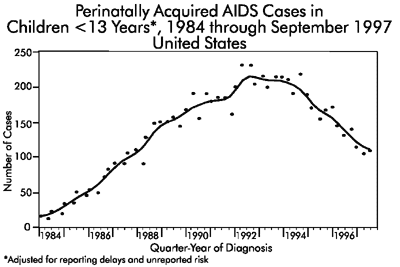
 |
Status of Perinatal HIV Prevention -
U.S. Declines Continue:
Hope for Extending Success to Developing World
During the early 1990s, before perinatal preventive treatments were available, an
estimated 1,000-2,000 infants were born with HIV infection each year in the United
States. Today, the U.S. has seen dramatic reductions in mother-to-child, or perinatal,
HIV transmission rates. These declines reflect the widespread success of Public Health
Service (PHS) recommendations made in 1994 and 1995 for routinely counseling and
voluntarily testing pregnant women for HIV, and for offering zidovudine (AZT, also
called ZDV) to infected women during pregnancy and delivery, and for the infant after
birth.
Perinatal Prevention Saves Lives and Dollars On a national level, and in numerous states, studies continue to demonstrate that
perinatal HIV prevention is making a difference, both in terms of lives and resources
saved:
Despite these successes, challenges remain for further reducing HIV transmission to children in the United States, and for extending opportunities for perinatal prevention to nations in the developing world. Perhaps the greatest barriers in the U.S. are the continuing spread of HIV infection among minority women and the lack of early prenatal care for many of these women.
HIV Remains a Significant Problem for U.S. Women and Their Babies, Especially for Minority Women and Children
HIV infection in children is closely associated with the HIV epidemic in women. HIV transmission from mother to child during pregnancy, labor, and delivery or by breast-feeding has accounted for 91% of all AIDS cases reported among U.S. children. Obviously, the best way to prevent infection among children is to prevent infection in women.
Women of color and their children have always been disproportionately affected by the HIV epidemic. In 1997, of the 13,105 total AIDS cases reported among U.S. women, 10,458 (80%) were among African-American and Hispanic women. Of the 473 children reported with AIDS last year, 402 (85%) were African American and Hispanic. We must continue to improve HIV prevention efforts for women of color and ensure that interventions provide the information, skills, and support needed to reduce their HIV-related risks.
Moreover, perinatal HIV prevention efforts must work to ensure that all HIV-infected women are reached early in pregnancy with the opportunity to learn their HIV status and, if infected, to consider preventive therapy to improve the chances that their children will be born free of infection. Achieving this goal will require increased access to and utilization of prenatal care.
In addition to increasing access to preventive therapy in the United States, efforts must also focus on extending perinatal prevention to the developing world.
Critical Need to Extend Perinatal Prevention to the Developing World
Until recently, the only AZT regimen proven effective for perinatal HIV prevention was essentially out of reach for the countries where more than 90% of worldwide HIV infections occur. The AZT regimen used in the United States and other industrialized nations is costly and requires several months of treatment for the mother and the infant, and an intravenous dose during delivery that is not feasible in many developing countries. Additionally, HIV-infected mothers in these nations often have no practical alternative to breast-feeding, and this poses an additional risk of transmitting the virus to their newborns.
Earlier this year, researchers from CDC and the Ministry of Public Health in Thailand announced dramatic findings that offer real hope for extending perinatal prevention successes to many developing nations that previously had no realistic preventive options. Researchers found that a short course of AZT given late in pregnancy and during delivery reduced the rate of HIV transmission to infants of infected mothers by half and is safe for use in the developing world. However, the study did not address the efficacy of the regimen among women who breast-feed. Ongoing studies in Africa are expected to provide this critical information.
Policy makers believe that this regimen, using a much shorter course of AZT during pregnancy, an oral dose rather than an intravenous dose during delivery, and no infant dose, can more realistically be implemented in the developing world. The provision of safe alternatives to breast-feeding will still need to be addressed in every setting. The United Nations is now working with public health agencies around the globe to help make this short-course regimen available for as many women as possible and to continue to identify practical solutions for reducing the toll of the epidemic on women and children worldwide.
Go to the CDC Updates Menu
Go to the Vertical Transmission Menu
Go to the Women & Children Menu
Go to the HIVpositive.us Main Menu